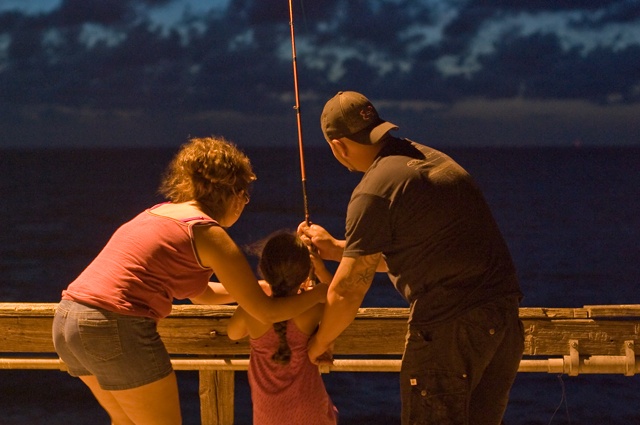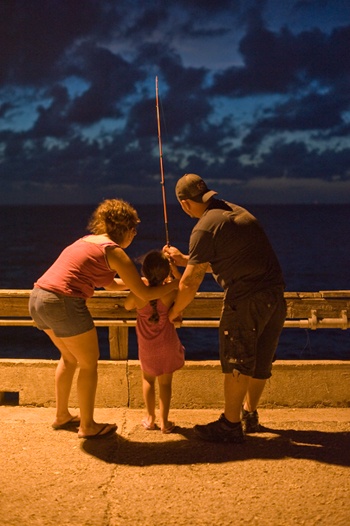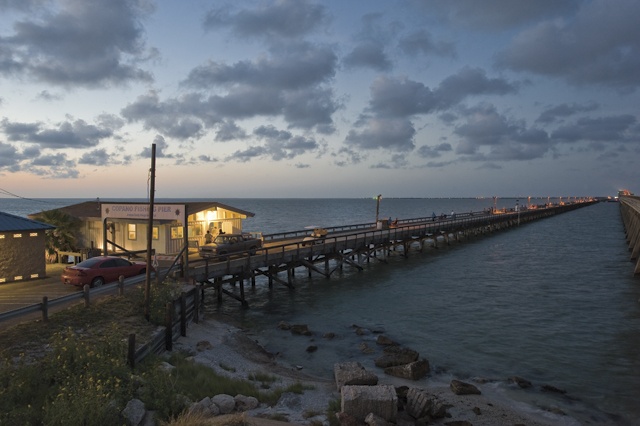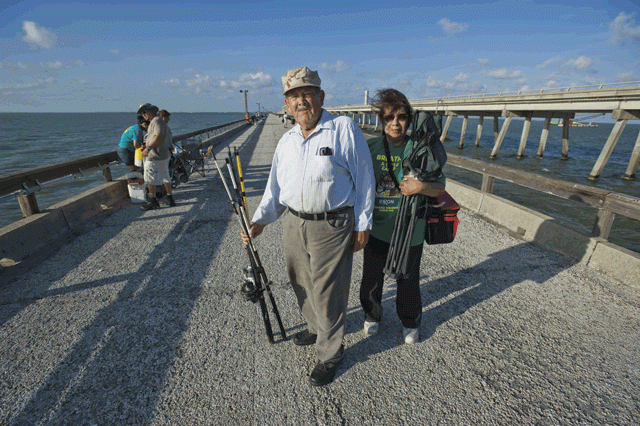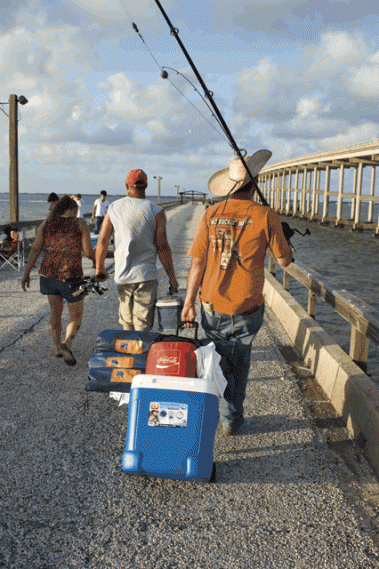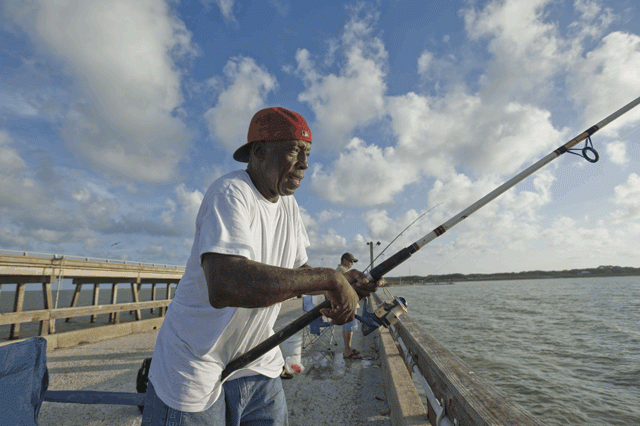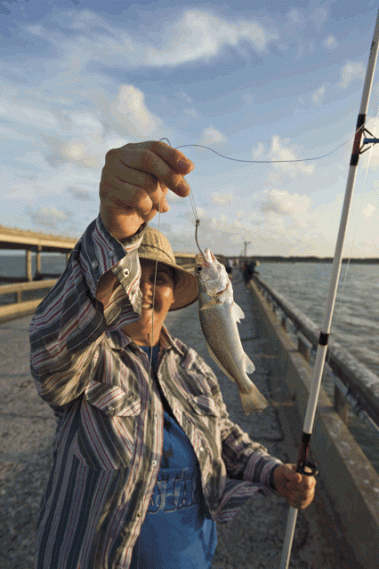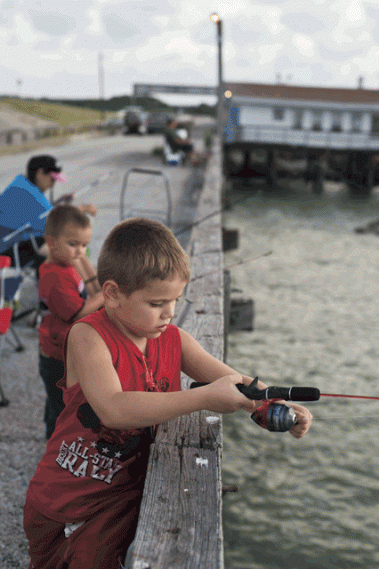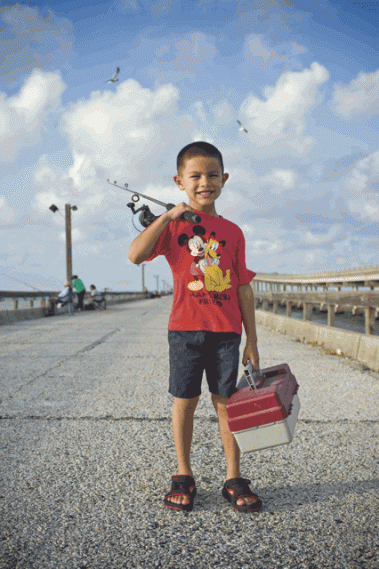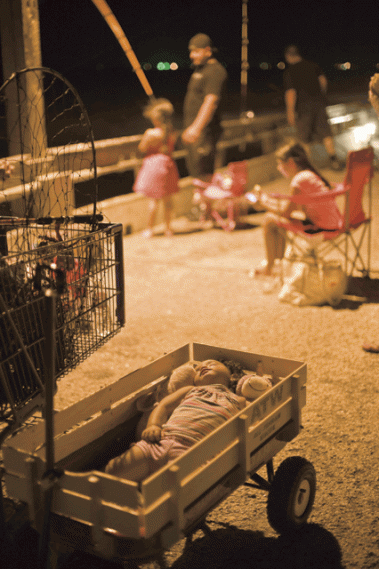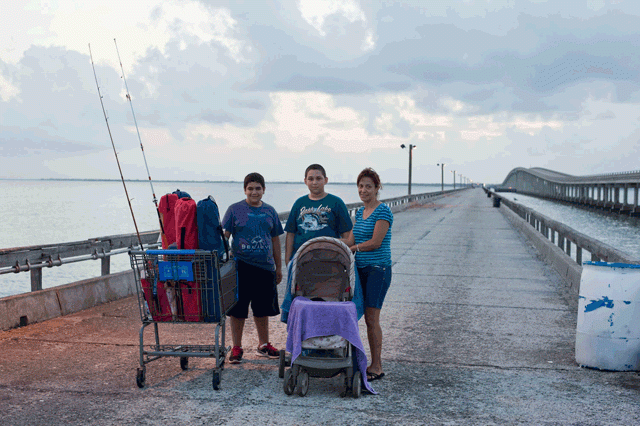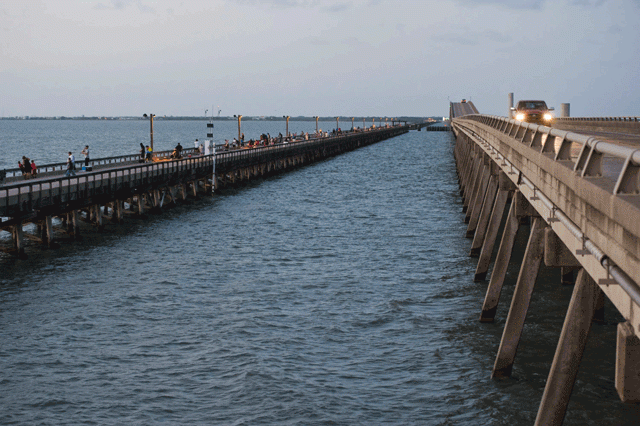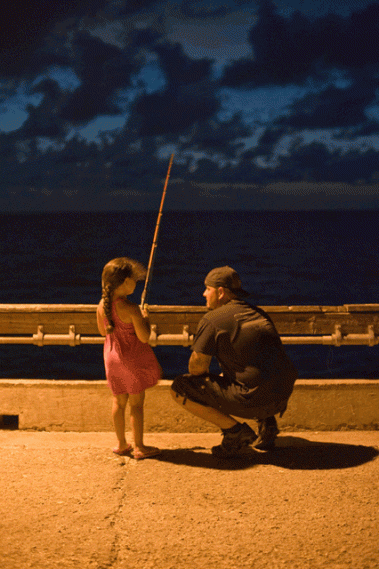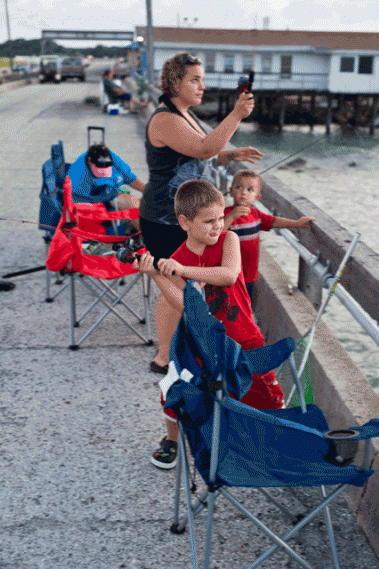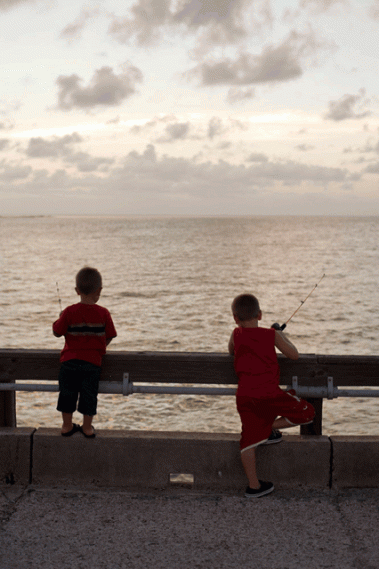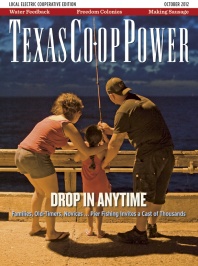This is everyman fishing—showing up with gear and bait and snacks and kids in tow to claim a spot on one of the piers jutting into the Gulf. It’s pretty much always a good time and, dare we say it, there’s no catch.
They come pushing their grocery carts, pulling ice chests on wheels. They come trailing their little red wagons loaded with kids and sandwiches and water and beers to fight dehydration and help keep off the dull times.
They ride bicycles and tricycles, baskets on the front or back or both, packed to overflowing with food and drink and boxes of stuff that will get them through a breezy coastal night or the stifling heat of a saltwater summer day.
Many nights, just as the sun is beginning to set far out across Copano Bay, you’ll see a motorized wheelchair, gliding quietly in and out among the carts and bikes out on the knobby, slightly potholed pavement of Copano Fishing Pier.
This once was State Highway 35 itself, the north-south link between Houston and Corpus Christi. Now it’s the old causeway, a public fishing pier—one of dozens up and down the Texas Gulf Coast—where for a few dollars and a box of frozen shrimp you can spend a day or a night fishing for whatever comes along.
All the conveyances—bikes and chairs and carts that once hauled groceries at the local supermarket—are festooned with rods and reels and bear some resemblance to weird rolling insects, antennae waving and poking into the evening sky.
Kids, able to contain their enthusiasm for only so long, run and yell and pepper adults with questions about where and when and how many. Parents indulge the older ones, often while pushing a stroller or carriage with an infant aboard.
Everybody is hauling fishing tackle—as much as possible and for every angling contingency—toward their favorite floodlight over the water, or the floodlight nobody has claimed yet. Different rods for different fish and different bait because no one wants to be caught standing out there with just their floppy hat in their hands when the action starts.
Steve Bailey, along with his wife, Lee, has driven down from Karnes City to near Rockport, to the former causeway that linked Rockport with areas north of the mouth of Copano Bay. He herds his kids—Kyle, 13, Megan, 10, and Ryan, 4—down past the first wave of anglers stationed over the water to a spot that features enough room for the clan.
Kyle is in the water first and already has a fish on before Bailey has rigged rods and reels for the younger siblings. Kyle pronounces the trip a success, even though he’s only caught a small croaker. This is what he came for, the thing that makes the 100-mile trip worth the effort.
There may be better Saturday nights ahead in his life, but right now, right here, this is perfect. A kid and a rod and reel. That’s karma and summer vacation and uptown Saturday nights all rolled into one.
“We just wanted to get the kids outside and enjoy some time together,” Bailey explains. Other than a few dollars for gas and maybe some shrimp for bait, the family will invest only a couple of dollars a rod in a full night’s entertainment, far less than going to a movie and a whole lot more fun.
Kyle releases his croaker and is rummaging around in the bait box for another shrimp when 4-year-old Ryan squeals and starts pumping upward on his own rod. Another croaker this time, reeled 20 feet above the water to help jump-start a young fishing career.
Just a few feet away, a lady screams and squeals and begins cranking against a heavier fish. But she’s watching the Bailey family closely. “There was a guy who caught two big redfish right under that same light earlier today,” she says. That’s what she’s hoping for, a nice redfish (red drum) that will turn a Saturday barbecue into a grill master’s delight.
Redfish on the half shell sounds good, but maybe she’s counting her fish eggs before they’ve hatched because what she’s caught—the wriggling, thrashing, slimy creature she’s managed to drag up to her spot along the bridge railing—is a hardhead. A notorious bait stealer with questionable morals, a hardhead is a less-than-palatable table presence but one that can deliver a nasty, painful and hard-to-heal wound via its pectoral and dorsal fins. Elation drowns in disappointment, and the woman whips out a pair of pliers to remove the hardhead and return it in a long throw to the waters below.
That fish could have been a redfish or a speckled trout, the two major saltwater game fish in Texas and the prize elements of a fish fry when the weekend is over. But there are other fish here: pompano and sand trout, croakers and flounder. Even the mighty king mackerel, sharks of every order, stingrays and giant, leaping tarpon will show up at the piers on some nights.
Pier regulars know when the best times arrive for different species, and you can see them trudging out on Copano Pier or Goose Island or Conn Brown or the famous Bob Hall Fishing Pier late in the day many days, setting up for the bull red run (giant red drum heading out to sea in the fall) or the flounder run or maybe an influx of surf breeds of sharks.
The big boys cruise the muddy brown and slightly murky waters around the piers, sometimes lapping up several baits in one trip down the rails. Anglers may start hollering “big fish” at one end and wind up sharing hooks and crossing lines with anglers 100 yards away. Those really big fish do get landed from time to time, but mostly they wreak havoc and swim back out to sea with a nest of broken and bent hooks hanging from lips that are as tough as rubber boots. The hooks will rust away in a few days, and the fish will be fine and ready to revisit the scene of old triumphs, just daring an angler to try to best them one-on-one.
The nice thing about fishing piers in Texas coastal waters—and we should probably include jetties, even though those manmade rock peninsulas that jut out into the Gulf have their own subset of anglers and fish—is that they are within almost anyone’s financial range. The Texas Parks and Wildlife Department offers free fishing in state parks; a license is not required. If you’re 16 and younger, you won’t need a fishing license or any stamps to fish in Texas. Those 17 and older must comply with state regulations for fishing licenses and stamps, according to Texas Parks and Wildlife.
The fishing piers are open year-round, and there’s fishing year-round unless there’s a hurricane blowing in. Nobody needs a boat or motor or waders or fancy rods and reels to enjoy the fishing there. In fact, utilitarian is probably better on the piers because anglers—unless they have special long-handled nets that can reach all the way to the water—are forced to use pretty heavy equipment and high-test lines to handle the sometimes large fish and always large weights required to get a bait to the bottom in a roaring current. Think 20-pound line, 200 to 300 yards of it, and a one-ounce weight with a 5/0 circle hook if you want to concentrate on the big boys. Think it even if you don’t, because you don’t get to choose what’s going to bite. Yours is but to reel and fight.
This is everyman fishing, where you’re likely to see kids and dogs and families enjoying the weather next to babes in bikinis fishing alongside old-time pier hard cores who’ve been doing this for 30 years or more. They may have their favorite spotlights they’ll hurry to reach before anyone else, and they’ll definitely be thinking they can’t understand why anyone would choose the confinement and dangers of a boat on a vast ocean when there’s a perfectly good pier and plenty of fish right there for the taking.
There’s a sense of camaraderie, too, where everyone out there catches a fish when anyone catches a fish, even though those old salts seem to catch more than their share. That’s the way of the world no matter where you’re fishing, but it’s true. You can fool all the fish some of the time, but those guys fool more than anyone else.
I’m not sure the reason—maybe it’s that saltwater fish have good taste—but shrimp has always been the bait of choice for pier anglers. You might see someone chunking artificial lures, but they aren’t accomplishing much most of the time. And occasionally, some of the serious guys will be using whole or cut bait, like mullet, in hopes of attracting a shark or a big tarpon. Ribbonfish and other kinds of bait will work, and lots of them are available at pier headquarters.
But you can have a full day or night of fishing with a box of cheap, frozen shrimp and a Sesame Street fishing rod if you’re inclined.
——————–
Mike Leggett is the outdoors writer at the Austin American-Statesman.
